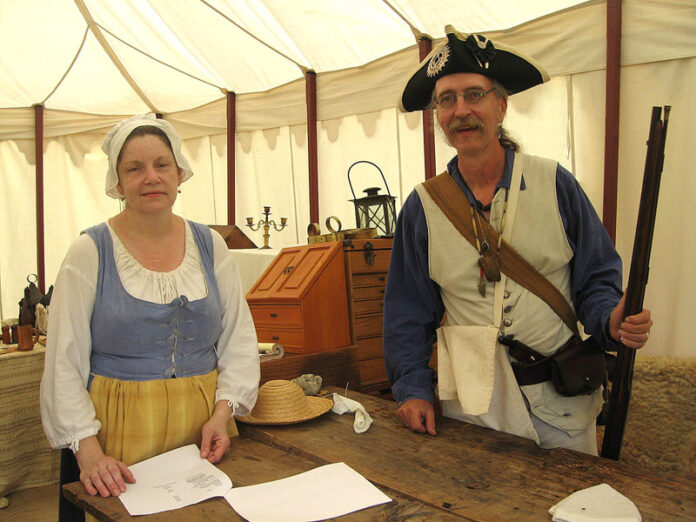
by Gail Lambert
A portion of Eastern Montgomery Park bristled with tents, gunfire, and smoke on the first Saturday and Sunday of August as Revolutionary War era costumed men, women and children mingled with 21st century visitors in their shorts and athletic shoes. They were there to mark the significance of the 18th century wagon trail that helped Americans settle Kentucky and the rest of the West.
Visitors were rewarded with talks by historians, an opportunity to throw tomahawks and knives at standing targets, and to shop for 18th century clothing, toys and equipment. An unhurried look at artifacts such as a soldier’s cooking stove, all set up, and smoking was in the offing, as well as the Camp Store with living historian Deborah Bryant in her cap and long dress explaining the merits of knee pants and stockings for growing boys. Black iron stakes for a soldier’s pack were used to build a cooking contraption.
Event Organizer Henry Bryant, resplendent in an 18th century style three-cornered hat and knee breeches, demonstrated the use of a flintlock musket. It required a number of steps and skills, and when the fiery blast exploded, the visitors had a much better sense of the meaning of the word “shellshock.”
Bryant asked for questions; one man wanted to know how many shots a soldier could fire in a minute. “Three or four,” Bryant answered. Spectators seemed taken aback, probably thinking, “Who could endure such noise and fright in the middle of battle?”
Victoria Ferguson, wearing the attire of a Monacan Indian, is a descendant of Jacob Persinger, an early Swiss-German settler in the Roanoke Valley as well as the descendent of a Monacan Indian who fought for the Americans at Yorktown. Salemite Sandy Thornton wore a simple shift with buckskin leggings and moccasins in honor of her Cherokee Nation ancestor who traveled West on the Great Road.
Featured author and retired Army officer Lee Offing, a Colonial American woodsman look-alike, showed on a map the blundering effort of the British military using American boys to fight in the Caribbean. It was a mistake Offing believes loosened the tight bond between Mother England and the American colonies decades before the Revolutionary War.
Historian Mary Kegley from Wytheville, author of “Finding Their Way from the Great Road to the Wilderness Road,” was also a featured speaker.
The Encampment was sponsored by Montgomery County Parks and Recreation and Fort Vause Outfitters. Admission was free. Neighboring Rowe Furniture Company donated a sofa for a fundraising raffle. It was the first of what many history buffs and families hope will be an annual event.



Thank you for your kind words. We are going to make it an annual event. The Great Road Encampment will be the first weekend in August 2012